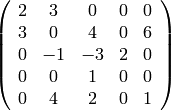Cvxopt provides many routines for solving convex optimization problems such as linear and quadratic programming packages. It also has a very nice sparse matrix library that provides an interface to umfpack (the same sparse matrix solver that matlab uses), it also has a nice interface to lapack. For more details on cvxopt please refer to its documentation at http://abel.ee.ucla.edu/cvxopt/documentation/users-guide/
Sparse matrices are represented in triplet notation that is as a list of nonzero values, row indices and column indices. This is internally converted to compressed sparse column format. So for example we would enter the matrix

by
sage: import numpy
sage: from cvxopt.base import spmatrix
sage: from cvxopt.base import matrix as m
sage: from cvxopt import umfpack
sage: Integer=int
sage: V = [2,3, 3,-1,4, 4,-3,1,2, 2, 6,1]
sage: I = [0,1, 0, 2,4, 1, 2,3,4, 2, 1,4]
sage: J = [0,0, 1, 1,1, 2, 2,2,2, 3, 4,4]
sage: A = spmatrix(V,I,J)
To solve an equation  , with
, with ![B=[1,1,1,1,1]](_images/math/41f2e7d451a97328802f7ae3ae5cf914a23fd292.png) ,
we could do the following.
,
we could do the following.
sage: B = numpy.array([1.0]*5)
sage: B.shape=(5,1)
sage: print(B)
[[ 1.]
[ 1.]
[ 1.]
[ 1.]
[ 1.]]
sage: print(A)
SIZE: (5,5)
(0, 0) 2.0000e+00
(1, 0) 3.0000e+00
(0, 1) 3.0000e+00
(2, 1) -1.0000e+00
(4, 1) 4.0000e+00
(1, 2) 4.0000e+00
(2, 2) -3.0000e+00
(3, 2) 1.0000e+00
(4, 2) 2.0000e+00
(2, 3) 2.0000e+00
(1, 4) 6.0000e+00
(4, 4) 1.0000e+00
sage: C=m(B)
sage: umfpack.linsolve(A,C)
sage: print(C)
5.7895e-01
-5.2632e-02
1.0000e+00
1.9737e+00
-7.8947e-01
Note the solution is stored in  afterward. also note the
m(B), this turns our numpy array into a format cvxopt understands.
You can directly create a cvxopt matrix using cvxopt’s own matrix
command, but I personally find numpy arrays nicer. Also note we
explicitly set the shape of the numpy array to make it clear it was
a column vector.
afterward. also note the
m(B), this turns our numpy array into a format cvxopt understands.
You can directly create a cvxopt matrix using cvxopt’s own matrix
command, but I personally find numpy arrays nicer. Also note we
explicitly set the shape of the numpy array to make it clear it was
a column vector.
We could compute the approximate minimum degree ordering by doing
sage: RealNumber=float
sage: Integer=int
sage: from cvxopt.base import spmatrix
sage: from cvxopt import amd
sage: A=spmatrix([10,3,5,-2,5,2],[0,2,1,2,2,3],[0,0,1,1,2,3])
sage: P=amd.order(A)
sage: print(P)
1
0
2
3
For a simple linear programming example, if we want to solve

sage: RealNumber=float
sage: Integer=int
sage: from cvxopt.base import matrix as m
sage: from cvxopt import solvers
sage: c = m([-4., -5.])
sage: G = m([[2., 1., -1., 0.], [1., 2., 0., -1.]])
sage: h = m([3., 3., 0., 0.])
sage: sol = solvers.lp(c,G,h) #random
pcost dcost gap pres dres k/t
0: -8.1000e+00 -1.8300e+01 4e+00 0e+00 8e-01 1e+00
1: -8.8055e+00 -9.4357e+00 2e-01 1e-16 4e-02 3e-02
2: -8.9981e+00 -9.0049e+00 2e-03 1e-16 5e-04 4e-04
3: -9.0000e+00 -9.0000e+00 2e-05 3e-16 5e-06 4e-06
4: -9.0000e+00 -9.0000e+00 2e-07 1e-16 5e-08 4e-08
sage: print sol['x'] # ... below since can get -00 or +00 depending on architecture
1.0000e...00
1.0000e+00